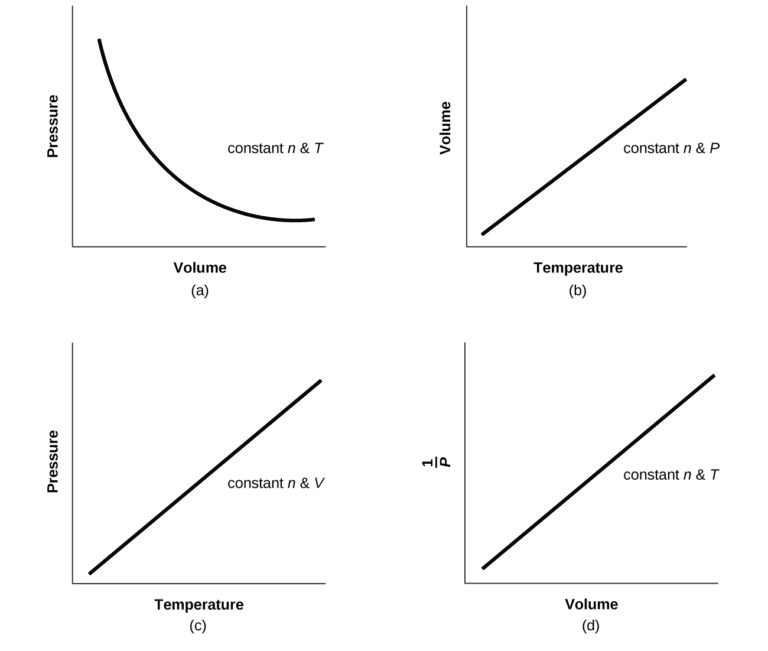Solutions to Chapter 8 Exercises
8.1 Solutions
1. The cutting edge of a knife that has been sharpened has a smaller surface area than a dull knife. Since pressure is force per unit area, a sharp knife will exert a higher pressure with the same amount of force and cut through material more effectively.
3. Lying down distributes your weight over a larger surface area, exerting less pressure on the ice compared to standing up. If you exert less pressure, you are less likely to break through thin ice.
5. 0.809 atm; 82.0 kPa
7. 2.2 × 102 kPa
9. Earth: 14.7 lb in–2; Venus: 13.1× 103 lb in−2
11. (a) 101.5 kPa; (b) 51 torr drop
13. (a) 264 torr; (b) 35,200 Pa; (c) 0.352 bar
15. (a) 623 mm Hg; (b) 0.820 atm; (c) 83.1 kPa
17. With a closed-end manometer, no change would be observed, since the vaporized liquid would contribute equal, opposing pressures in both arms of the manometer tube. However, with an open-ended manometer, a higher pressure reading of the gas would be obtained than expected, since Pgas = Patm + Pvol liquid.
8.2 Solutions
1. As the bubbles rise, the pressure decreases, so their volume increases as suggested by Boyle’s law.
3. (a) The number of particles in the gas increases as the volume increases. (b) temperature, pressure
5. The curve would be farther to the right and higher up, but the same basic shape.
7. 16.3 to 16.5 L
9. 3.40 × 103 torr
11. 12.1 L
13. 217 L
15. 8.190 × 10–2 mol; 5.553 g
17. (a) 7.24 × 10–2 g; (b) 23.1 g; (c) 1.5 × 10–4 g
19. 5561 L
21. 46.4 g
23. For a gas exhibiting ideal behavior:

25. (a) 1.85 L CCl2F2; (b) 4.66 L CH3CH2F
27. 0.644 atm
29. The pressure decreases by a factor of 3.
8.3 Solutions
1. 4.64 g L−1
3. 38.8 g
5. 72.0 g mol−1
7. 88.1 g mol−1; PF3
9. 141 atm
11. CH4: 276 kPa; C2H6: 27 kPa; C3H8: 3.4 kPa
13. Yes
15. 740 torr
17. (a) Determine the moles of HgO that decompose; using the chemical equation, determine the moles of O2 produced by decomposition of this amount of HgO; and determine the volume of O2 from the moles of O2, temperature, and pressure. (b) 0.308 L
19. (a) Determine the molar mass of CCl2F2. From the balanced equation, calculate the moles of H2 needed for the complete reaction. From the ideal gas law, convert moles of H2 into volume. (b) 3.72 × 103 L
21. (a) Balance the equation. Determine the grams of CO2 produced and the number of moles. From the ideal gas law, determine the volume of gas. (b) 7.43 × 105 L
23. 42.00 L
25. (a) 18.0 L; (b) 0.533 atm
27. 10.57 L O2
29. 5.40 × 105 L
31. XeF2
8.4 Solutions
1. 4.2 hours
3. Effusion can be defined as the process by which a gas escapes through a pinhole into a vacuum. Graham’s law states that with a mixture of two gases A and B: . Both A and B are in the same container at the same temperature, and therefore will have the same kinetic energy:
Therefore,
5. F2, N2O, Cl2, H2S
7. 1.4; 1.2
9. 51.7 cm
8.5 Solutions
1. Yes. At any given instant, there are a range of values of molecular speeds in a sample of gas. Any single molecule can speed up or slow down as it collides with other molecules. The average velocity of all the molecules is constant at constant temperature.
3. H2O. Cooling slows the velocities of the He atoms, causing them to behave as though they were heavier.
5. (a) The number of collisions per unit area of the container wall is constant. (b) The average kinetic energy doubles. (c) The root mean square speed increases to times its initial value; urms is proportional to
.
7. (a) equal;
(b) less than;
(c) 29.48 g mol−1;
(d) 1.0966 g L−1;
(e) 0.129 g/L;
(f) 4.01 × 105 g; net lifting capacity = 384 lb;
(g) 270 L; (h) 39.1 kJ min−1
